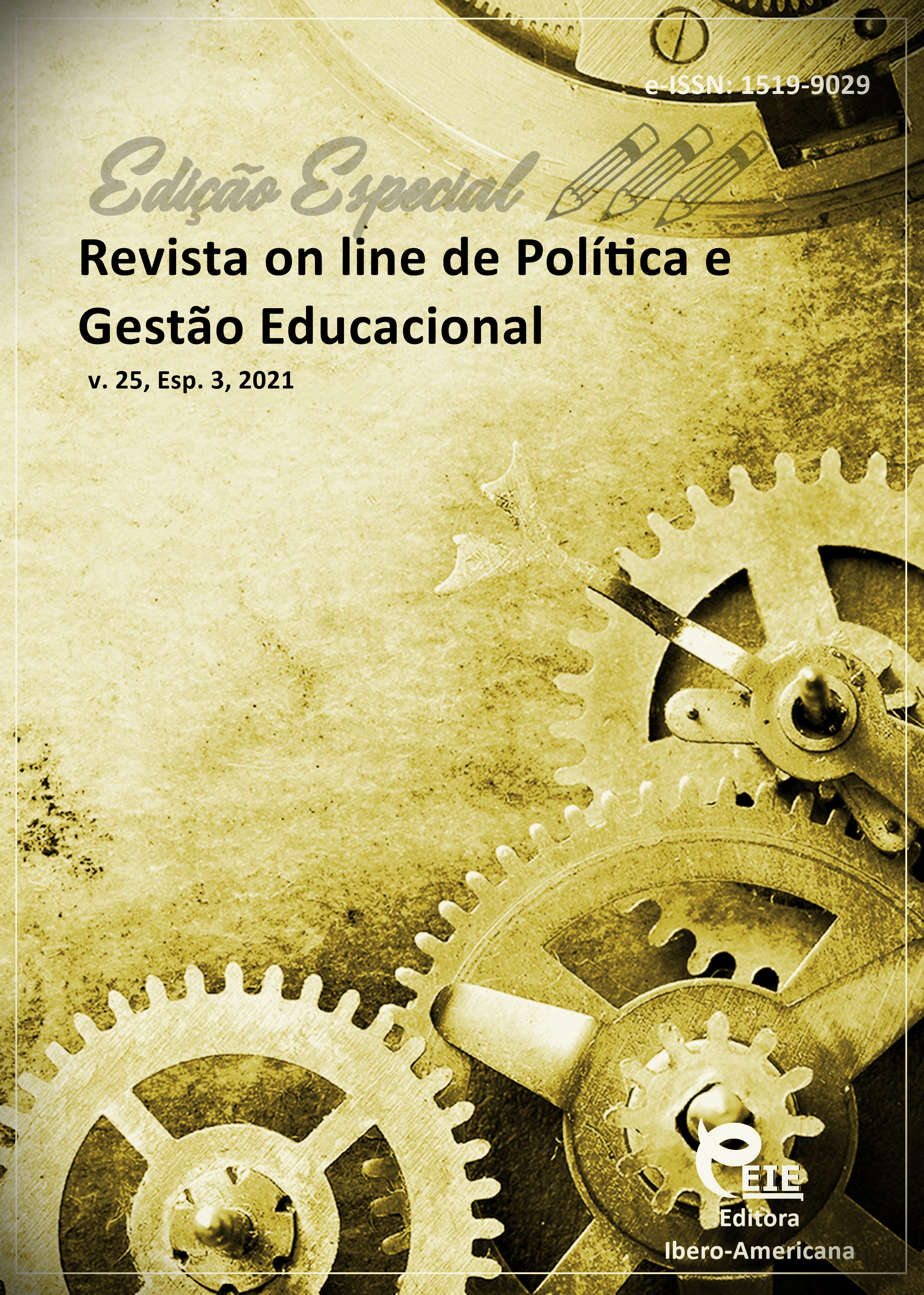Perspectivas para a aplicação de métodos ativos de aprendizagem na educação moderna
DOI:
https://doi.org/10.22633/rpge.v25iesp.3.15587Palavras-chave:
Educação moderna, Métodos ativos de aprendizagem, Abordagens inovadoras, Perspectivas de aplicaçãoResumo
O artigo examina as perspectivas de aplicação de métodos ativos de aprendizagem na educação moderna. A pesquisa mostra que as perspectivas de aplicação de métodos ativos de aprendizagem na educação moderna são condicionados pela influência de diversos fatores. Esses fatores podem ser divididos em vários grupos: organização abrangente do ensino, construção de uma comunicação adequada, uso de novas tecnologias de aprendizagem, organização da educação voltada para a personalidade e trabalho em equipe. A pesquisa mostrou que existem barreiras reais e potenciais para os professores usarem métodos de ensino inovadores, mas não existe um paradoxo sério. Não há dúvida de que existe um intenso interesse nas perspectivas e no futuro da aplicação de métodos ativos de aprendizagem na educação moderna e sua aplicação na educação. Ao escolher um método de ensino, deve-se levar em consideração a capacidade dos professores de usar esse método e as condições locais.
Downloads
Referências
ALIYEV, B.; JABBAROV R. The problem of personality in education.Baku, Educa¬tion, 2008, 136 p. Available: https://lsu.edu.az/new/LSU-Library/l¬b/Stud¬ent_¬/psyc¬holo¬gy.¬php
APEL, H. J. Predavanje, uvod u akademski oblik poucavanja, Zagreb: EruditA,2003. Available: https:¬//libra¬ry.foi.hr/lib/¬knjiga¬.php?B=2¬0&H=&E¬=&V=Y¬&lok
ASTİN, A.W. What matters in college? Four critical years revisited. Jossey-Bass.1993 Available: https://psycnet.apa.org/record/1992-98891-000
AKMHETOVA, G.K. System of Professional Development of Pedagogical Staff in the Republic of Kazakhstan: Update Strategy.Almaty:University of Kazakhstan, 2016, 90 p.
AKSARİN, S. Investigation of the problems of innovative pedagogical activity in the modern vocational education system. Yugorsk State University Bulletin, V.1 (36), p.17-19, 2015. Available: https://cyberleninka.ru/article/n/issledovanie-problem-innova¬tsion¬noy
BEİCHNER, R. J. History and Evolution of Active Learning Spaces. New Directions for Teaching and Learning, 2014, 9-16. Available: http:¬//¬dx.doi.org/10.1002/tl.20081
BOEKAERTS, M.; MUSSO, M.; CASCALLAR, E. Self-Regulated Learning and the Understanding of Complex Outcomes. Educational Psychology International, 2012, 1-81. http://dx.doi.org/10.1155/2012/686385
BONÜELL, C. C.; EİSON, J. A. Active learning: Creating Excitement in the Classroom. ASHE-ERIC, Higher Education Report n. 1.1991, Washington, DC: George Washington University. Available: https://eric.ed.gov/?id=ED336049
BROCKLİSS, L. Curricula. A History of the University in Europe. Cambridge (Reino Unido): Cambridge University Press,1996, Vol. 2., pp.565-620. Available: https:/¬/www-.scirp¬org/(¬S(351jm¬bntv nsjt1aadkp oszje)) /refer ence/Re ferences Paper s.aspx ?ReferenceID=1542008
CLOVİS, L.K.; MARTHA B.A.; PEDRO H.M. Active Teaching and Learning Meth-odologies: Some Considerations, Creative Education, 2015, 6, 1536-1545. Available: http://www¬.scirp.org/ journal /cehttp://d x.doi .org/1 0.423 6/ce.20 15.6 14154
DOYLE, T. Helping Students Learn in a Learner-Centered Envi¬ronment: A Guide to Facilitating Learning in HigherEducation. Sterling, VA: Stylus Publishing. 2008. Available: https://www.¬scirp.org/(S¬(i43dyn45¬teexjx455qlt¬3d2q))/r¬efer¬encaspx?ReferenceID=1542011
FELDER, R.M.; BRENT R. “Learning by Doing.” Chem. Engr.Educ¬ation,2003, 37(4),282-283. Available: https://¬www.¬eng r.ncsu.edu/wp-content/u¬ploads/d¬rive/1¬XaOo9¬WCK¬cMq6-fTcQG¬idOT2¬SDGq¬g70l5/2009-ALpaper(ASQ).pdf
FREEMAN, S.; EDDY, S. L.; MCDONOUGH, M.; SMİT, M. K.; OKOROAFOR, N.; JORDT, H.; WENDEROTH, M. P. Active Learning Increases Students’ Performance in Science, Engineering, and Mathematics. Proceedings of the National Academy of Sciences of the United States of America, 2014, 111, 8410-8415. Available: http://¬www.¬pnas.¬org/-cont¬ent/111/23/8410.full.pdf
HAKE, R. R. Interactive-Engagement vs. Traditional Methods: A Six-Thousand-Student Survey of Mechanics Test. Data for Introductory Physics Courses. American Journal of Physics, 1998, 66, 64. Available: http://dx.doi.org/10.1119/1.18809
HALPERN, D. F.; HAKEL, M. D. Applying the Science of Learning to the University and Beyond: Teaching for Long-Term Retention and Transfer. Change, 2003, 35, 36-41. Available: http://dx.doi.org/10.1080/00091380309604109
INMACULADA C.; MARİA A.; ESTER T. Motivation for the academic reading of future tea¬chers. Educação & Formação Educ. Form., Fortaleza, 2021, v. 6, n. 1, e3535. DOI: https://d¬oi.org/1¬0.25053¬/reduf¬or.v6i1¬.3535
JUNGES, F.C.; KETZER, C. M.; OLİVERA, V. M. Continued teacher training: Ressignficated knowledge and transformed teaching practices. Educação & Formação, Fortaleza, v.3, n.9, p. 88-101, set./dez. 2018. DOI: https:¬//doi.org¬/10.2505¬3/redu¬for.
KRASNOV, S.I. Norms of social design and simulation of innovation. Problems of design in the work of graduate students of OR RAO for 1994 – 1995. Available: ¬https:/¬/cyber¬leni-nka.¬ru/arti¬cle¬/n/instrumentariy-institutsionalnogo-modelirovaniya.
LUCKESİ, C. C. Assessment of school learning: paths taken. Doctoral thesis. Graduate Program in Philosophy of Education. PUC-SP, 1994. Available: http://w¬ww.¬lef¬fa.pro¬.br/te-la4/T¬extos¬
MOCİNİC, S. N. Active teaching strategies in higher education. Metodicki obzori ,2012, 15, vol. 7; 2. DOI: https:/¬¬/doi.org/¬10.32728/mo.07.2.2012.08
MOHAMMED O.; SEİD D.; ABDURAHMAN T. The Practice and Prospects of Active Learning Methods in Wollo University, American Scientific Research Journal for Engi-neer¬ing, Technology, and Scie¬nces, 2020, Volume 65, No 1, pp 1-15.
NAZAROV, A. Modern learning technologies. Textbook. ADPU-publishing house. Baku: 2012, 103 p. Available: http://anl.az/el/Kitab/Azf-269214.pdf
PRİNCE M. J. Does Active Learning Work? A Review of the Research. Journal of Engineering Education,2004, 93, 223-231. Available: http://d¬x.doi.¬org/10.¬1002/¬j.2168-9830-0¬809.x
ROÜE, M. B. Pausing Principles and Their Effects on Reasoning in Science. In F. B. Brawer (Ed.), Teaching the Sciences: New Directions for Community Colleges, 1980, pp. 27-34. San Francisco: Jossey-Bass. Available: http://dx.doi.org/10.1002/cc.36819803106
STİENER-HAMSEY, G. How NGOs react: globalization and education reform in the Caucasus, Central Asia and Mongolia. Kumarskaya press, v.31 (2), p.25-36, 2018. DOI: 10.1111 / j. 1467-873X.2008.00426.x.
TAGUNOVA, I.A.; SELİVANOVA, N.L.; VLEEVA, R.A. The category of upbringing in Russian and western studies. Mathematics Education, V.11(1), p.3-9, 2016. DOI: 10.12973/i ser.201 6.2101a.
ZANCHİN, M. R. Le strategie attive, u AA.VV., Le interazioni educative, Roma: Armando, 2002.
Downloads
Publicado
Como Citar
Edição
Seção
Licença
Copyright (c) 2021 Revista on line de Política e Gestão Educacional

Este trabalho está licenciado sob uma licença Creative Commons Attribution-NonCommercial-ShareAlike 4.0 International License.
Manuscritos aceitos e publicados são de propriedade da Revista on line de Política e Gestão Educacional. É vedada a submissão integral ou parcial do manuscrito a qualquer outro periódico. A responsabilidade do conteúdo dos artigos é exclusiva dos autores. É vedada a tradução para outro idioma sem a autorização escrita do Editor ouvida a Comissão Editorial Científica.











